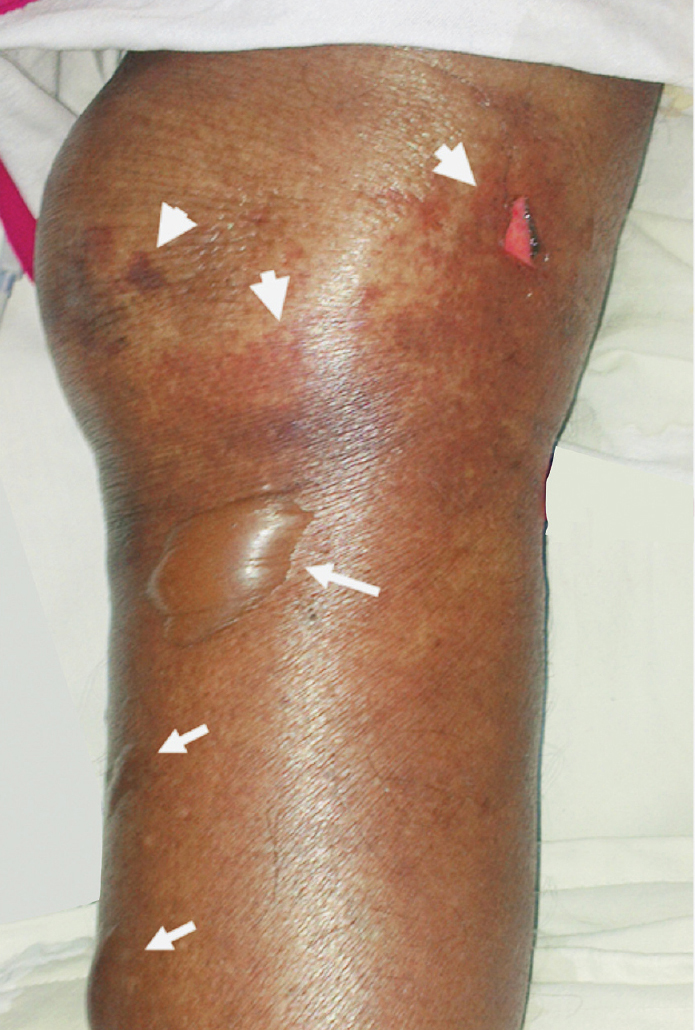Translate this page into:
Infectious purpura fulminans
*For correspondence: alladimohan@svims.gov.inalladimohan@rediffmail.com
This is an open-access article distributed under the terms of the Creative Commons Attribution-Noncommercial-Share Alike 3.0 Unported, which permits unrestricted use, distribution, and reproduction in any medium, provided the original work is properly cited.
This article was originally published by Medknow Publications & Media Pvt Ltd and was migrated to Scientific Scholar after the change of Publisher.
A 60 year old male patient was admitted to the medical intensive care unit (MICU) at the Sri Venkateswara Institute of Medical Sciences, Tirupati, Andhra Pradesh, in October 2013, with acute exacerbation of chronic obstructive pulmonary disease, acute respiratory failure requiring mechanical ventilatory support. While on treatment he developed new onset fever and evidence of septic shock. Pseudomonas bacteraemia was evident on blood culture. Laboratory work-up revealed a low platelet count (25,000/µl); prolonged prothrombin time (test = 18.4 sec, control = 13.2 sec) and activated partial thromboplastin time (test = 38 sec, control = 32 sec); decreased serum fibrinogen level (80 mg/dl) which was suggestive of overt disseminated intravascular coagulation (DIC) with a score of 5 as per the International Society for Thrombosis and Haemostasis (ISTH) Diagnostic Scoring System12. The patient developed characteristic skin lesions over the right lower limb (Figure) and succumbed to his illness within 48 hours of onset of these lesions.

- Photograph showing non-blanchable, purple coloured skin lesions with well defined margins (arrow heads) along with bullae (arrows) containing clear fluid suggestive of infectious purpura fulminans.
Purpura fulminans is an acute, often lethal syndrome characterized by DIC. It starts as well-demarcated erythematous macules that progress rapidly with haemorrhagic necrosis resulting in dark raised lesions, with vesicle or bulla formation3. It has been observed in severe acute bacterial infections caused by Neisseria meningitidis, Streptococcus pneumoniae, Group A and B streptococci, Staphylococcus aureus, Haemophilus influenzae, Plasmodium falciparum malaria and heritable protein C pathway defects4. Pseudomonas bacteraemia is an uncommon cause of purpura fulminans. It is important to recognize this uncommon cutaneous manifestation of systemic sepsis early and institute appropriate aggressive management as it is associated with a high mortality.
References
- Guidelines for the diagnosis and management of disseminated intravascular coagulation. British Committee for Standards in Haematology. Br J Haematol. 2009;145:24-33.
- [Google Scholar]
- Scientific Subcommittee on Disseminated Intravascular Coagulation (DIC) of the International Society on Thrombosis and Haemostasis (ISTH). Towards definition, clinical and laboratory criteria, and a scoring system for disseminated intravascular coagulation. Thromb Haemost. 2001;86:1327-30.
- [Google Scholar]
- Modern concepts of the diagnosis and treatment of purpura fulminans. J Environ Pathol Toxicol Oncol. 2008;27:191-6.
- [Google Scholar]
- Purpura fulminans: recognition, diagnosis and management. Arch Dis Child. 2011;96:1066-71.
- [Google Scholar]





